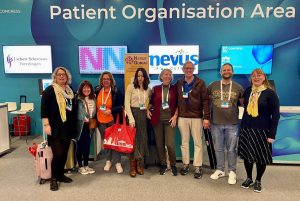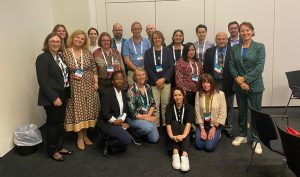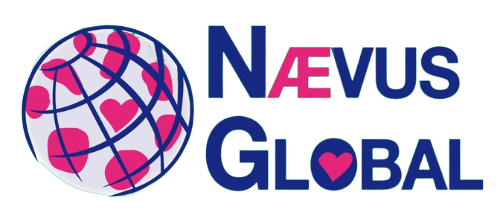European dermatology congress
October 11-14, 2023. Berlin

This year, 2023, the EADV (European Academy of Dermatology & Venereology) congress was organized in Berlin. It was a very large conference with more than 600 speakers from more than 50 countries with 15,800 participants. Naevus Global was present with Whitney Casal (Nevus Outreach), Benjamin Löffler (Nävus Netzwerk Deutschland), and Marjolein van Kessel (Nevus Netwerk Nederland).
Patient Organisation Area
 Since 2018, patient organizations have been given the opportunity to present themselves during the EADV conference. We would like to demonstrate the added value of collaboration, because through our information provision and contact with fellow sufferers we can do a lot for the care of people with congenital moles.
Since 2018, patient organizations have been given the opportunity to present themselves during the EADV conference. We would like to demonstrate the added value of collaboration, because through our information provision and contact with fellow sufferers we can do a lot for the care of people with congenital moles.
Unfortunately, we notice that this does not come naturally. We believe that we as patient organizations are not sufficiently visible to the participants (particularly doctors and medical students). In 2022 in Milan (Italy) we were literally in the basement. We also felt that the location in Berlin, a short distance from registration, was not good for us. The presentations were given in a different hall, participants did not easily walk past us. Each organization was given a 2-hour time slot with a very small box. Formally, it was not allowed to use banners or paper (leaflets/brochures). No organization took any notice of this.
Improvement of patient organization area
What was noticeable is that, over time, a close bond formed between the various patient organizations. A task force has been set up with patient representatives, Global Skin, and a few dermatologists from the EADV organization. We have collected ideas on how we would like to improve our position and this will be elaborated upon at the next EADV meeting in 2024 in Amsterdam.

Attending presentations
Many sessions were medically oriented and often dealt with different syndromes than vascular diseases.
We attended a very interesting parallel session on ‘psychodermatology in clinical practice’ by Prof. Dr. Anthony Bewley. His presentation clearly showed the effect of skin conditions on the patient’s mental health.
- A total of 98% of patients with a skin condition indicated that it has a major effect on their emotional and psychological well-being.
- 2.5% of people with a skin condition have suicidal thoughts.
A possible solution is an integrated treatment plan (model for person-centered communication) in which the doctor looks at the medical condition (signs, symptoms and research) and the patient from personal understanding (feelings, ideas, function and expectations).
The effects of a chronic skin condition on a patient’s physical and psychological well-being can impact many areas:
- Study.
- Relationships.
- Social activities.
- Career.
- Sex life.
- Leisure activities.
General psychosocial problems that people with chronic skin conditions face:
- Low opinion of oneself.
- Negative image of their body.
- Social isolation.
- Impacted sex life.
- Lower quality of life.
Some aspects of the financial burden:
- Problems finding work.
- More likely to experience financial constraints.
- More likely to be unfit to work.
- More time absent due to (medical) appointments and illness.
- Relationship between employer and employee.
- Increased risk of anxiety and depression.
Emotional pain hurts more than physical pain. ~ Prof. Dr. Anthony Bewley
Prof. Dr. Anthony Bewley advocates 4 minutes extra time during consultations to listen to psychological problems. Let patients determine their own goals and motivate them to do so.
Presentations of dermatologist and patient representatives together
Dr. Bibi van Montfrans (dermatologist Erasmus Medical Center Rotterdam) and Lex van der Heijden gave a presentation together. The title of this presentation was ‘Solving a challenge together in access to care for vascular malformations’.
The purpose of this presentation was to show the added value of collaboration between doctors and patient organizations. Bibi gave an example of a number of patient ‘cases’ and Lex responded with how we would approach this as a patient organization. The key word here is ‘personal’ from the CMTC-OVM organization. The first step is to make as much personal contact as possible, especially via a video call, not only to get acquainted but also to understand the situation as best as possible and to identify the request for help so that we can provide the best personalized support.
Dr. Antoni Gostynski (dermatologist, Maastricht University Medical Center), Mandy Aldwin, and Karin Veldman indicated that the challenge for people with ichthyosis lies in improving care in all countries, limited treatment options, little research, and challenges in reimbursement. Together (doctors and patients) they work on a guideline and conduct research into quality of life.


